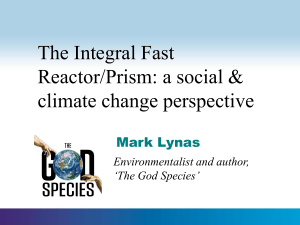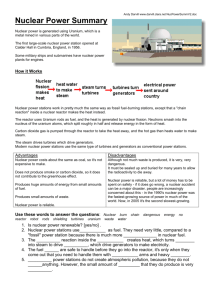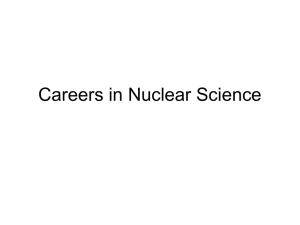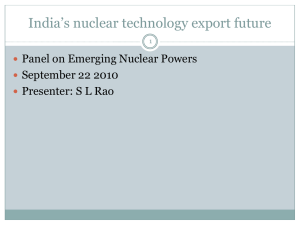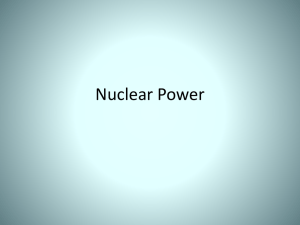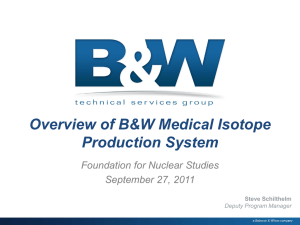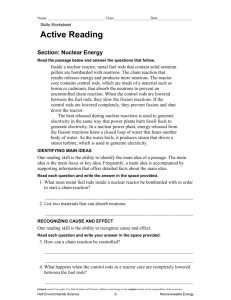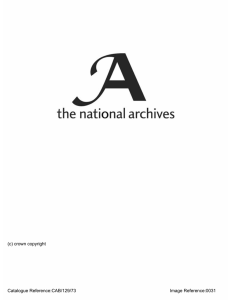Nuclear Power - energy from splitting Uranium atoms
advertisement
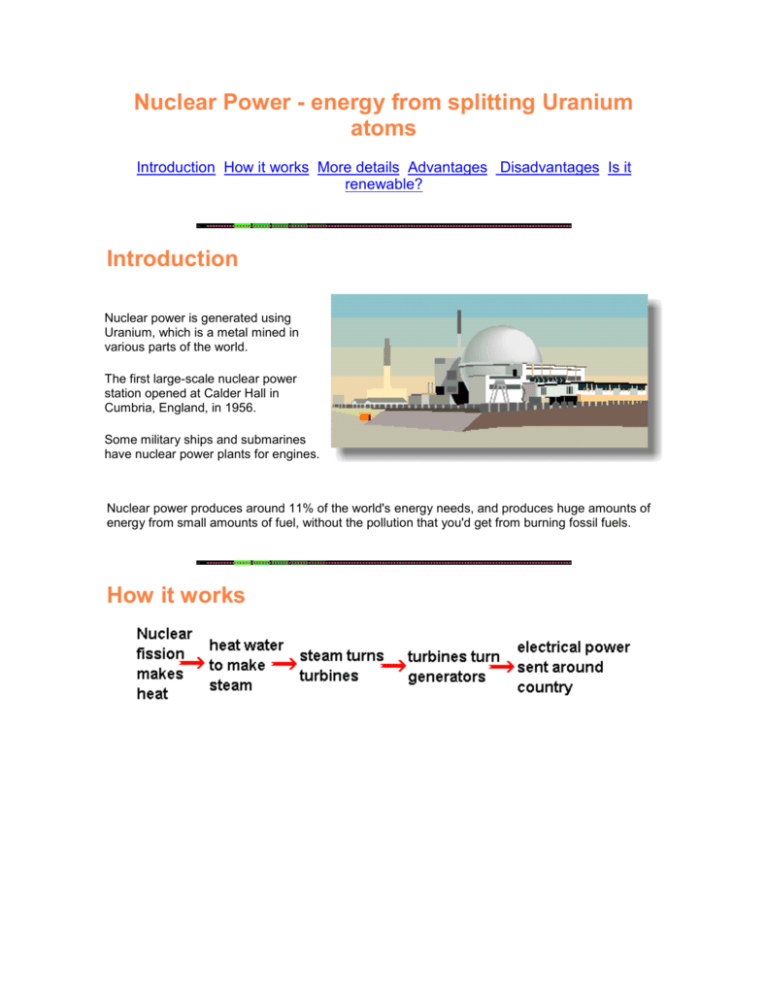
Nuclear Power - energy from splitting Uranium atoms Introduction How it works More details Advantages Disadvantages Is it renewable? Introduction Nuclear power is generated using Uranium, which is a metal mined in various parts of the world. The first large-scale nuclear power station opened at Calder Hall in Cumbria, England, in 1956. Some military ships and submarines have nuclear power plants for engines. Nuclear power produces around 11% of the world's energy needs, and produces huge amounts of energy from small amounts of fuel, without the pollution that you'd get from burning fossil fuels. How it works Nuclear power stations work in pretty much the same way as fossil fuel-burning stations, except that a "chain reaction" inside a nuclear reactor makes the heat instead. The reactor uses Uranium rods as fuel, and the heat is generated by nuclear fission. Neutrons smash into the nucleus of the uranium atoms, which split roughly in half and release energy in the form of heat. Carbon dioxide gas is pumped through the reactor to take the heat away, and the hot gas then heats water to make steam. The steam drives turbines which drive generators. Modern nuclear power stations use the same type of turbines and generators as conventional power stations. In Britain, nuclear power stations are built on the coast, and use sea water for cooling the steam ready to be pumped round again. This means that they don't have the huge "cooling towers" seen at other power stations. The reactor is controlled with "control rods", made of boron, which absorb neutrons. When the rods are lowered into the reactor, they absorb more neutrons and the fission process slows down. To generate more power, the rods are raised and more neutrons can crash into uranium atoms. More details Natural uranium is only 0.7% "uranium-235", which is the type of uranium that undergoes fission in this type of reactor. The rest is U-238, which just sits there getting in the way. Modern reactors use "enriched" uranium fuel, which has a higher proportion of U-235. The fuel arrives encased in metal tubes, which are lowered into the reactor whilst it's running, using a special crane sealed onto the top of the reactor. Carbon dioxide gas is blown through the reactor to carry the heat away. Carbon dioxide is chosen because it is a very good coolant, able to carry a great deal of heat energy. It also helps to reduce any fire risk in the reactor (it's around 600 degrees Celsius in there) and it doesn't turn into anything nasty (well, nothing long-lived and nasty) when it's bombarded with neutrons. You have to be very careful about the materials you use to build reactors - some materials will turn into horrible things in that environment. If a piece of metal in the reactor pressure vessel turns brittle and snaps, you're probably in trouble. Uranium itself isn't particularly radioactive, so when the fuel rods arrive at the power station they can be handled using thin plastic gloves. A rod can last for several years before it needs replacing. It's when the "spent" fuel rods are taken out of the reactor that you need the full remote-control robot arms and Homer Simpson equipment. Nuclear power stations are not atomic bombs waiting to go off, and are not prone to "meltdowns". There is a lot of U-238 in there slowing things down - you need a high concentration of U-235 to make a bomb. If the reactor gets too hot, the control rods are lowered in and it cools down. If that doesn't work, there are sets of emergency control rods that automatically drop in and shut the reactor down completely. With reactors in this country, the computers will shut the reactor down automatically if things get out of hand (unless engineers intervene within a set time). At Chernobyl, in Ukraine, they did not have such a sophisticated system, indeed they over-rode the automatic systems they did have. When they got it wrong, the reactor overheated, melted and the excessive pressure blew out the containment system before they could stop it. Then, with the coolant gone, there was a serious fire. Many people lost their lives trying to sort out the mess. If something does go wrong in a really big way, much of the world could be affected - some radioactive dust (called "fallout") from the Chernobyl accident landed in the UK. With AGR reactors (the most common type in Britain) there are additional safety systems, such as flooding the reactor with nitrogen and/or water to absorb all the neutrons although the water option means that reactor can never be restarted. Nuclear power stations in England are open to the public. Visit http://www.bnfl.com/index.aspx?page=150 to find out more about how nuclear power stations work - choose a "Brief Overview" or "In depth" from their menu Advantages Nuclear power costs about the same as coal, so it's not expensive to make. Does not produce smoke or carbon dioxide, so it does not contribute to the greenhouse effect. Produces huge amounts of energy from small amounts of fuel. Produces small amounts of waste. Nuclear power is reliable. Disadvantages Although not much waste is produced, it is very, very dangerous. It must be sealed up and buried for many years to allow the radioactivity to die away. Nuclear power is reliable, but a lot of money has to be spent on safety - if it does go wrong, a nuclear accident can be a major disaster. poeple are increasingly concerned about this in the 1990's nuclear power was the fastest-growing source of power in much of the world. Now, in 2005 it's the second slowest-growing. Is it renewable? Nuclear energy from Uranium is not renewable. Once we've dug up all the Earth's uranium and used it, there isn't any more. Actually, it's not that simple - we can use "fast breeder" reactors to convert uranium into other nuclear fuels whilst also getting the energy from it. There are two types of breeder reactors - ones that make weapons-grade plutonium and ones that are for energy production. Find out more about breeder reactors
